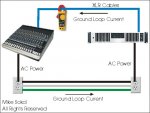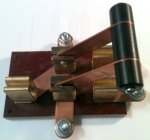Modulated ground loops
Modulated ground loops
I got one for ya:
I took a Crown Macro-Tec 2400 in bridge mode connected the output speaker wires one to the EGC at the mixer board receptacle and the other at a stage receptacle that was on the sub-panel that also fed the amp rack, I just hooked up a mic into one of the XLR inputs of the amp and the mixerboard was not even on just the amp rack, and their jaws about dropped when I flipped the switch on the mic and spoke and about sent all the amps into clipping, then they started putting it together:happyyes:
Good thing for me that crowns especially Macro-Tec will take a 1 ohm load and not even break a sweat
An interesting and terrifying demonstration. I've often heard ground loops being modulated by music because when the amplifiers draw AC power on loud song dynamics, the extra voltage drop in the hot and neutral will show up in the safety ground if it has been improperly bonded to the neutral on a branch circuit. This sounds like a 60 Hz "false" note under the actual music, and really bugs me. But I've never thought about turning it around and modulating the ground loop current with music so instead of hum in the speaker, you hear voice or music in the speakers. Very cool, but also very dangerous for all but the most robust power amplifiers, which as you suggest, Crown Macro-Tec amps are in their own class. I think you could arc weld with them if need be...

I could add this modulation of ground loop currents into my own rig with a much smaller power amp by using a 200 watt, 4-ohm to 70 volt audio distro transformer backwards, so a small amp (200 watts) in bridge mode would power the 70-volt side of the transformer. I would then have a nice low-impedance and ground isolated secondary to insert into my ground loop path in addition to my Glo-Melt soldering transformer for the AC hum demonstration. I picked up this cool looking knife switch from a car wiring manufacturer last year, and it's the perfect thing for switching the low-impedance output of a reversed 70-volt transformer into the ground loop path.
Nobody get excited about me opening up safety grounds in a building. This is a table-top demonstration rig that's under my complete control and supervision. And the knife switch with exposed copper bus bars will only see ground potential and a few volts ground loop differential, so it's safe to use for a demonstration.
Too much fun... I'll post a picture when it's complete.
Remember, the entire reason for this ground loop demonstration is to promote correctly wired power outlets in remodeling and new installations that won't cause ground loop hum in sound systems. Ground loop hum is what causes musicians and sound techs to cut off the ground pins on their power amp extension cords to stop the noise. But that can also create a hot-chassis condition, where musicians are shocked when they touch guitar strings and a microphone at the same time. A NCVT is a great tool to check for these hot-chassis voltages on stage instruments and mics. They typically trigger around 40 volts AC, which is a good place to start. Not as good as testing from a known ground to a microphone with a DMM, but NOBODY will do that unless a musician was knocked out or killed on stage. There's simply not enough time during a show to use a DMM on a grounded wire, but certainly you can walk around the stage with a NCVT and poke it at all the stage amps and microphones in a minute or two.



